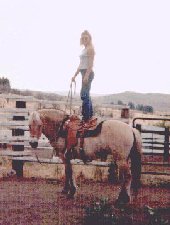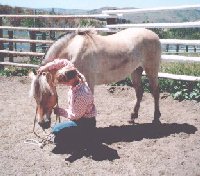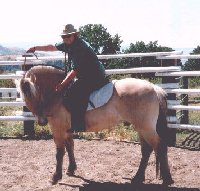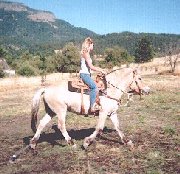
Katie Lay on Harmony, 4th day of training

What is Natural Horsemanship? Well, there are a number of personal styles and an equal number of places where you can get an explanation direct from a variety of world class ‘horse whisperers’, so this is just a very brief review (see our LINKS page for some further suggestions).
Basically, Natural Horsemanship is a way of interacting with your horse using the horse’s methods of thinking and communication. There are a number of basic principles involved, but lets look at just a few.
Horses are prey animals. Nature
is set up so that prey animals are hunted by predators. Predators include
animals like cougars, wolves, and... humans. Understandably predators and
prey have very different approaches to life and staying alive. Horses are
very successful at being what they are - that’s why they’ve been around
for so long. Nature has endowed them with certain traits that have allowed
them to survive as a species. One of these traits relates to the concept
of ‘fight or flight’. When faced with danger, or something unusual, a predator
will initially turn towards it and carefully approach to investigate -
might be food! If it’s turf, there’s going to be a fight. A horse, on the
other hand, will investigate from a distance and probably flee. Nature
tells it to. Horses are so keyed on this concept that they will do it for
what we would consider the most trivial reasons. Have you ever seen a horse
spook or balk at going into their favorite pasture because the gate has
swung 'out' instead of ‘in’ like it usually is? Or because there is a pile
of brush  that
wasn’t there yesterday? You might not even notice, or if you did, you probably
wouldn’t care. But to a horse it is DIFFERENT. That could mean danger and
their hot-wired response system kicks into gear.
that
wasn’t there yesterday? You might not even notice, or if you did, you probably
wouldn’t care. But to a horse it is DIFFERENT. That could mean danger and
their hot-wired response system kicks into gear.
A horse will usually want to approach an 'unknown' diagonally so it always keeps an avenue of escape open. A predator (including humans) will usually come head on - and the horse reacts. Other things come into play as well; horses smell like grass because that’s what they eat while humans smell like meat for the same reason. Predators attack by jumping on the back of their prey - which is where you are when you’re riding. All of these kinds of factors can make humans scary creatures to horses.
As predators, our visual system focuses a pair of eyes on a single point and we tend to concentrate our awareness within our immediate area. A horse’s brain is split right down the middle. What one side sees or learns doesn’t get communicated to the other side (this is why you must perform the same lesson from both sides of a horse). They also consider their area of awareness perhaps a 1/4 mile in front of and behind them so they’re going to respond to things you’re not even aware of. In addition, the way their brain works causes them to see movement differently. As they approach something, they may see it as approaching them! So the whole world looks and acts much differently to a horse than it does to a human.
Therefore, when a horse acts afraid,
in most cases it IS afraid. This can be very frustrating to a human and
usually causes us to become even more predatory than we already are; we
tighten up, hunch our shoulders, raise our voice, increase our focus and
of course that just makes things worse. If you react by getting angry or
punitive, you can cause the horse to catalog you and experiences related
to you as ‘fight or flight’ material. If you quit the lesson or activity
at the point of failure, you teach the horse that it can evade your goals
by simply being stubborn or behaving  in
the extreme. If instead you reflect with understanding, respond appropriately,
and hang in there until you achieve even a small piece of success,
you can educate the horse positively and gain its trust as your partner.
in
the extreme. If instead you reflect with understanding, respond appropriately,
and hang in there until you achieve even a small piece of success,
you can educate the horse positively and gain its trust as your partner.
This is what Natural Horsemanship enables you to do. It teaches you to understand the physical and mental makeup of a horse from its perspective and its often very subtle physical language and to use it as a tool. We all use body language constantly, but we usually don’t pay conscious attention to it. We actively talk and listen and absorb the body language on a subconscious level. Horses speak with their bodies and listen with their eyes (or their skin in the case of a kick, poke or bite). If you want to effectively communicate with someone that speaks a different language, the best way is to learn to speak and understand that language. It’s the same with horses.
The concept of fairness and levels of response is another good example. Every horse has its own threshold of response. If a sensitive horse doesn’t respond to a command and you immediately move up to a much stronger emphasis, you’ve walked right into that ‘fight or flight’ turf again. The Natural Horsemanship concept is to start light and slowly work your way up until you get the desired result and then work at that point. You can increase or decrease your emphasis depending on the responses you get. Horses are big on fairness and pay a great deal of attention to levels of response. If you’re not attending to levels of response and consistently exceed them, a horse interprets this as being ‘unfair’ and will relate to you accordingly.
This all comes naturally to horses.
And what isn’t hot-wired is taught from birth, which is why we find it
to be the perfect process to compliment our foal imprinting.
To work for people, it takes a fair amount of time, mental and physical
work as well as patience. But what worthwhile relationship doesn’t require
alot of ongoing effort? If you want a safe and satisfying ride or if all
you want is respect when you walk through a group of horses, it’s worth
checking out. However, all the books, webpages, and videos in the world
can’t be a substitute for experience. Go see it, and if you like what you
see, take a some lessons - your horses did.

Katie riding Harmony, 6th day of training
HOME
PICTURE GALLERY
LINKS
OUR
PHILOSOPHY Our Mares
Shota Fjords